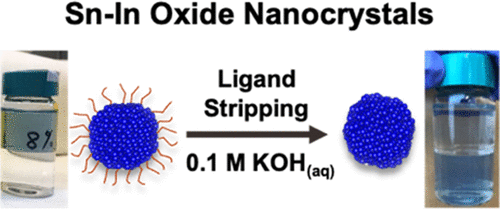当前位置:
X-MOL 学术
›
Chem. Mater.
›
论文详情
Our official English website, www.x-mol.net, welcomes your
feedback! (Note: you will need to create a separate account there.)
Efficient Aqueous Electroreduction of CO2 to Formate at Low Overpotential on Indium Tin Oxide Nanocrystals
Chemistry of Materials ( IF 7.2 ) Pub Date : 2021-09-20 , DOI: 10.1021/acs.chemmater.1c01649 Huei-Ru “Molly” Jhong 1 , Uzoma O. Nwabara 2 , Sofia Shubert-Zuleta 3 , Nicholas S. Grundish 4 , Bharat Tandon 1 , Lauren C. Reimnitz 1 , Corey M. Staller 1 , Gary K. Ong 1 , Camila A. Saez Cabezas 1 , John B. Goodenough 4 , Paul J. A. Kenis 2 , Delia J. Milliron 1
Chemistry of Materials ( IF 7.2 ) Pub Date : 2021-09-20 , DOI: 10.1021/acs.chemmater.1c01649 Huei-Ru “Molly” Jhong 1 , Uzoma O. Nwabara 2 , Sofia Shubert-Zuleta 3 , Nicholas S. Grundish 4 , Bharat Tandon 1 , Lauren C. Reimnitz 1 , Corey M. Staller 1 , Gary K. Ong 1 , Camila A. Saez Cabezas 1 , John B. Goodenough 4 , Paul J. A. Kenis 2 , Delia J. Milliron 1
Affiliation

|
Electroreduction of CO2 to formate powered by renewable energy offers an alternative pathway to producing carbon fuels that are traditionally manufactured using fossil fuels. However, achieving simultaneously high partial current density (jHCOO–), high product selectivity (Faradaic efficiency (FEHCOO–)), and low overpotentials (η) remains difficult due to the lack of suitable catalysts. Here, we report the electroreduction of CO2 on Sn-doped indium oxide (ITO) nanocrystal catalysts in an alkaline flow electrolyzer. Colloidally synthesized monodisperse 20 nm ITO nanocrystals (NCs) with various Sn-doping levels (0, 1, 5, 6.5, 8, and 12 atom %) were studied. We find that ITO NC catalysts exhibit a high selectivity for production of HCOO– over CO and H2 (approximately 87% HCOO–, 1–4% CO, and 2–6% H2 at −0.85 V vs RHE), an onset potential for HCOO– as early as −0.21 V vs RHE, and a high partial current density for HCOO– up to 171 mA/cm2 at a cathode potential of −1.08 V vs RHE. The main difference between the catalysts’ performances resides in the onset potential for formate production. The onset of formate production occurred at cell and cathode overpotentials of only −440 and −143 mV, respectively, by the 12% ITO. Analysis of the ITO electrodes before and after electrolysis suggests that no changes in surface composition, crystal structure, or particle size occur under the reduction conditions. Tafel slopes of ITO NC catalysts range from 27 to 52 mV per decade, suggesting that the rate-determining step is likely the proton-coupled electron transfer to CO2●–* to form HCOO–*.
中文翻译:

在氧化铟锡纳米晶体上在低过电位下有效地将 CO2 水电还原为甲酸盐
由可再生能源提供动力的 CO 2电还原为甲酸盐为生产传统上使用化石燃料制造的碳燃料提供了另一种途径。然而,由于缺乏合适的催化剂,同时实现高部分电流密度 ( j HCOO – )、高产品选择性(法拉第效率 (FE HCOO – )) 和低过电位 (η) 仍然很困难。在这里,我们报告了 CO 2的电还原在碱性流动电解槽中的 Sn 掺杂氧化铟 (ITO) 纳米晶体催化剂上。研究了具有各种 Sn 掺杂水平(0、1、5、6.5、8 和 12 原子%)的胶体合成单分散 20 nm ITO 纳米晶体 (NC)。我们发现,ITO NC 催化剂对生产 HCOO – 的选择性高于 CO 和 H 2(在 -0.85 V vs RHE 下大约 87% HCOO –、1–4% CO 和 2–6% H 2),这是一个开始HCOO 的潜力–早于 -0.21 V vs RHE,以及 HCOO 的高局部电流密度–高达 171 mA/cm 2在 -1.08 V 相对于 RHE 的阴极电位。催化剂性能之间的主要区别在于甲酸盐生产的起始潜力。12% ITO 在电池和阴极过电位分别仅为 -440 和 -143 mV 时开始产生甲酸盐。对电解前后 ITO 电极的分析表明,在还原条件下,表面成分、晶体结构或粒径没有发生变化。ITO NC 催化剂的塔菲尔斜率范围为每十年 27 至 52 mV,表明速率决定步骤可能是质子耦合电子转移到 CO 2 ●– * 以形成 HCOO – *。
更新日期:2021-10-12
中文翻译:

在氧化铟锡纳米晶体上在低过电位下有效地将 CO2 水电还原为甲酸盐
由可再生能源提供动力的 CO 2电还原为甲酸盐为生产传统上使用化石燃料制造的碳燃料提供了另一种途径。然而,由于缺乏合适的催化剂,同时实现高部分电流密度 ( j HCOO – )、高产品选择性(法拉第效率 (FE HCOO – )) 和低过电位 (η) 仍然很困难。在这里,我们报告了 CO 2的电还原在碱性流动电解槽中的 Sn 掺杂氧化铟 (ITO) 纳米晶体催化剂上。研究了具有各种 Sn 掺杂水平(0、1、5、6.5、8 和 12 原子%)的胶体合成单分散 20 nm ITO 纳米晶体 (NC)。我们发现,ITO NC 催化剂对生产 HCOO – 的选择性高于 CO 和 H 2(在 -0.85 V vs RHE 下大约 87% HCOO –、1–4% CO 和 2–6% H 2),这是一个开始HCOO 的潜力–早于 -0.21 V vs RHE,以及 HCOO 的高局部电流密度–高达 171 mA/cm 2在 -1.08 V 相对于 RHE 的阴极电位。催化剂性能之间的主要区别在于甲酸盐生产的起始潜力。12% ITO 在电池和阴极过电位分别仅为 -440 和 -143 mV 时开始产生甲酸盐。对电解前后 ITO 电极的分析表明,在还原条件下,表面成分、晶体结构或粒径没有发生变化。ITO NC 催化剂的塔菲尔斜率范围为每十年 27 至 52 mV,表明速率决定步骤可能是质子耦合电子转移到 CO 2 ●– * 以形成 HCOO – *。











































 京公网安备 11010802027423号
京公网安备 11010802027423号